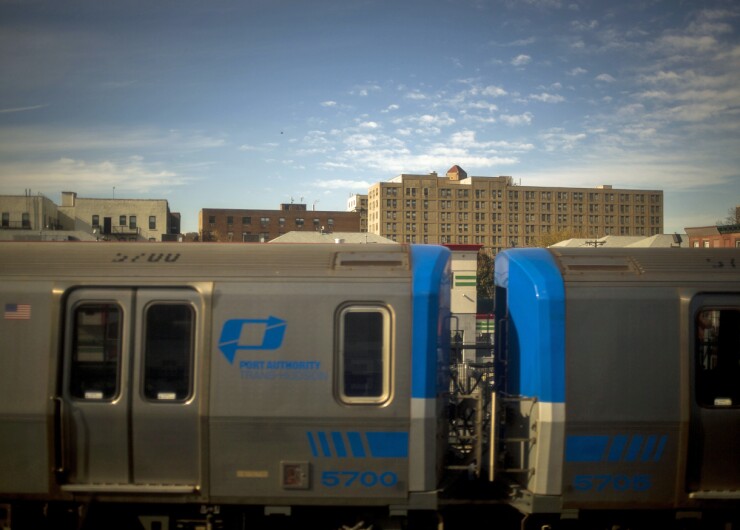The Port Authority of New York and New Jersey is trying to prepare for increased ridership on its century-old rail transit system through more than $1 billion of investment.
The “PATH Improvement Plan” unveiled by the bi-state agency on June 20 sets a goal for raising capacity on the Port Authority Trans-Hudson Newark-World Trade Center line by 40% in three years, and a collective 20% on the system’s other three lines. The planned spending includes new train cars and enhancing infrastructure at stations so they are equipped to accommodate larger vehicles.

“Increasing the carrying capacity of a legacy rail system by 20-40% in a three-year period is almost unheard of, but PATH is making that commitment,” Port Authority Executive Director Rick Cotton said in a statement. “We want this plan to be game-changing.”
A big component of the Port Authority’s PATH initiative involves a new $80 million commitment for converting the heavily traveled Newark to WTC line from eight to nine car-trains that would run every three minutes during rush hour periods by 2022. The large-scale capital investment for PATH capacity increases includes $750 million for new signals that would allow it to run more trains per hour, along with a prior $215.7 million commitment for 72 new rail cars to be rolled out beginning in 2021. The Port Authority is also committing an additional $50 million for initiatives to reduce delays and improve customer service.
“The PATH Improvement Plan is a comprehensive and forward-thinking approach to fixing the biggest problems facing PATH,” Port Authority Chairman Kevin O’Toole said in a statement. “By adding cars and trains, hitting back at the root cause of delays, and focusing on the customer experience, PATH will make monumental changes that affect the lives of the nearly 300,000 customers who rely on PATH each day.”
The 72 new train cars will join PATH’s existing fleet of 350 cars with the first set to debut in 2021. The $80 million planned for accommodating the longer trains includes infrastructure improvements at Jersey City’s Grove Street Station to tear down existing walls and extend the existing platform. Station modifications are also planned for Exchange Place Station in Jersey City to open more corridors for emergency exits.
PATH handled an April monthly record for ridership with 7,063,001 total passenger trips marking a 2.3% increase from the year earlier period. Port Authority officials noted that the ridership uptick highlighted increasing weekday growth trends since the April record, was set despite Saturday and Sunday closures of the World Trade Center Station for Hurricane Sandy repairs.
Janna Chernetz, senior New Jersey policy analyst for the Tri-State Transportation Campaign, said PATH service enhancements are crucial given ongoing challenges with the New Jersey Transit commuter rail system. PATH has increased service recent years when NJ Transit has been forced to reduce its number of trains because of repairs needed on tracks or at Manhattan’s Penn Station. She noted that NJ Transit is at risk for further disruptions in the near future because of delays to the
“No one mode of transportation can absorb the other,” Chernetz said. “PATH is a critical component of solving our cross-Hudson needs.”
Since joining Tri-State in 2011, Chernetz has focused much of her work on enhancing economic development in New Jersey through the connection of land use and transportation. She said the added PATH capacity is needed to keep up with a number of new apartment complexes sprouting up near stations in Harrison, Jersey City and Hoboken.
“The transportation infrastructure needs to support the housing demand,” she said. “It needs to be reliable and convenient to allow the development to ultimately be successful.”
The Port Authority announced on June 24 plans to increase tolls and fares across its large transportation network to support
The current $2.75 single-ride PATH fare would not be raised in the Port Authority’s proposal, but the cost of the 10-trip SmartLink option would increase to $26 in 2020 from $25. A seven-day SmartLink card would jump to $36 from $34 with 30-day users paying $110.25 in 2010 compared with $106 in 2019.
The Port Authority is one of the nation’s largest municipal bond issuers with $22.1 billion in bonded debt outstanding at the end of 2018, according to its year-end

Seth Lehman, senior director at Fitch Ratings and lead analyst on the Port Authority, said increasing PATH service capacity takes on added importance because of an increasing number of New Jersey commuters now working in downtown Manhattan because of increasing development around One World Trade Center. He noted that increased volume across the Port Authority’s transportation assets including bridges, tunnels and airports gives the agency financial flexibility to focus on PATH.
“They are very well-positioned if they have to increase the transportation budget for their capital needs,” Lehman said. “PATH is a small component of whole Port Authority enterprise, but there still need to be investments.”
In addition to bolstering capacity, the Port Authority is also rolling out a PATH delay reduction initiative addressing six key causes of delays including track conditions, switch failures, car equipment failures, signal equipment issues, sick passengers and unattended bags. PATH is also looking to implement a new fare-payment system by 2022 that would be integrated with the OMNY contactless "tap-and-go" system recently introduced by New York’s Metropolitan Transportation Authority as a pilot program in some Manhattan subway stations and on Staten Island buses.
The Port Authority also has long-term plans to extend PATH service from Newark Penn Station to nearby Newark Liberty International Airport. The project would link riders to airport's AirTrain station, now serviced by NJ Transit and Amtrak. The bi-state agency budgeted $1.7 billion for the extension in its 10-year capital plan two year ago.





